I have been, or can be if you click on a link and make a purchase, compensated via a cash payment, gift, or something else of value for writing this post. As an Amazon Associate, I earn from qualifying purchases. Please read my full Affiliate Disclosure for more information.
Ever wondered how to create a space that feels both calming and stylish, effortlessly blending the best of Japanese and Scandinavian design? Japandi interiors have taken the design world by storm, celebrated for their serene simplicity, warm earthy tones, and balanced harmony. This captivating aesthetic offers a peaceful retreat from the chaos of everyday life, making it increasingly popular among those seeking cozy yet sophisticated living spaces.
In this article, you’ll discover a treasure trove of moodboard ideas that inspire you to craft your perfect Japandi haven. From soothing color palettes to natural textures and clever storage solutions, each idea is designed to help you bring tranquility and elegance into your home.
Whether you’re a design novice or a seasoned decorator, these diverse inspirations will guide you in creating a peaceful sanctuary that beautifully marries modern minimalism with timeless tradition. Serene and uncluttered, minimalist neutral color palettes lay the foundation for a calming Japandi interior, transforming any space into a sanctuary of clarity.
These subdued hues foster a sense of peace and help create an environment where simplicity reigns supreme. Imagine a room painted in soft, warm beige, accented with gentle greys and earthy taupes that evoke a natural, grounding feel.
The furniture features clean lines in light wood finishes, such as ash or birch, complemented by textiles like linen cushions in creamy whites or muted taupe. The overall aesthetic is airy and spacious, with surfaces free of excess decoration, allowing the subtle variations in tone and texture to shine through.
The tactile experience is soothing—smooth ceramics, soft woven throws, and natural fibers invite touch, while the quiet color scheme enhances a feeling of tranquility that extends beyond sight. Recreating this look is simple and accessible: start with a neutral paint or wall covering in shades like warm beige or light grey.
Incorporate furniture in light woods, choosing pieces with sleek, minimal profiles. Add textiles such as a linen throw blanket in soft cream or a wool rug in muted earth tones for warmth and texture.
To complete the palette, select decorative ceramics or vases in neutral hues, which serve as understated accents that harmonize with the overall calm aesthetic. This approach ensures your space feels balanced, peaceful, and effortlessly stylish.
2. Natural Wood Finishes and Furniture for Warmth and Simplicity
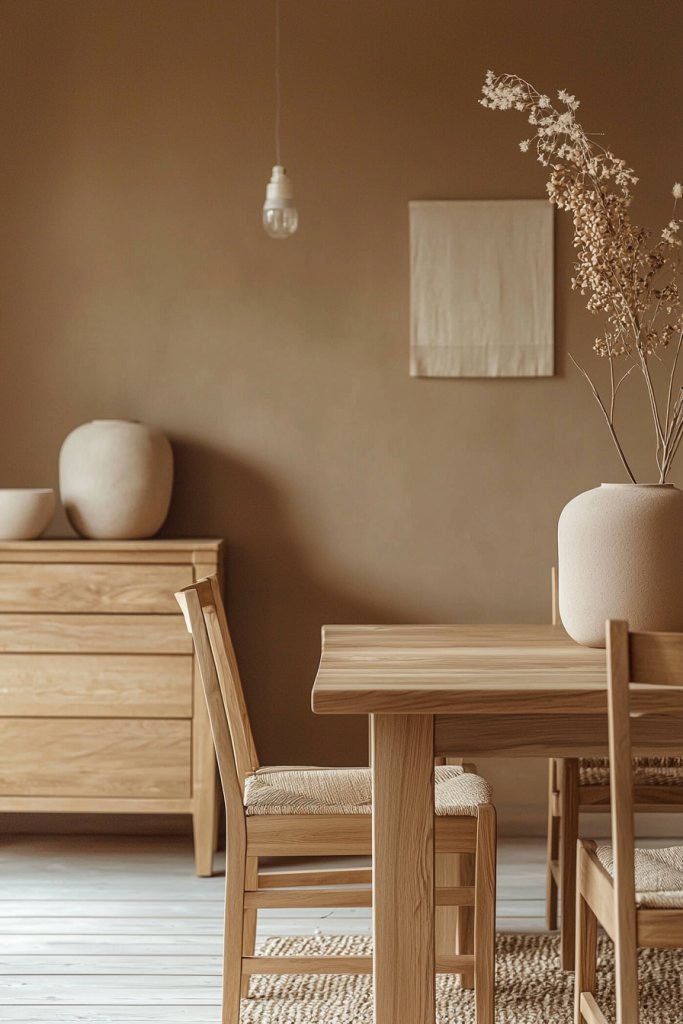
Natural wood finishes and furniture are the cornerstone of creating a warm, inviting Japandi space that exudes simplicity and serenity. They bring an organic touch that harmonizes the minimalist aesthetic with a cozy, lived-in feel, making your home both stylish and comfortable.
Recommended Products to replicate this idea
| # | Preview | Product | |
|---|---|---|---|
| 1 |

|
LITTLE TREE Dining Table for 6 People, Wooden Table, Rectangle Furniture with Heavy Duty Legs,... | Check Latest Price |
| # | Preview | Product | |
|---|---|---|---|
| 1 |

|
Best Choice Products 55" Modern 4-Door Sideboard Storage Cabinet, Buffet, Media Cabinet, Cupboard,... | Check Latest Price |
Imagine a room where light-colored oak and walnut furniture sit gracefully against soft, muted backgrounds—think warm beige walls and gentle greys. Smooth, matte finishes on tables and chairs highlight the natural grain of the wood, adding subtle texture without overwhelming the senses.
Tactile elements like a chunky wood coffee table or sleekly crafted sideboards create a sensory experience that invites touch and appreciation. The scent of natural wood, combined with the quiet ambiance of the space, fosters a peaceful, grounding atmosphere perfect for relaxation.
To recreate this look, start with essential pieces like a light oak dining table or a dark walnut sideboard, choosing options with visible wood grain for added warmth. You can find these in stores or opt for DIY projects using natural wood veneer or unfinished furniture for a more custom feel.
Pair your wood furniture with neutral-toned textiles, such as linen cushions or cotton throws, to soften the overall look. Simple assembly and a little sanding or oiling can refresh older pieces, making this a practical and achievable way to infuse your home with natural warmth and understated elegance.
3. Low-Profile Seating for Comfortable, Grounded Living

Low-profile seating is the perfect way to achieve a relaxed, grounded atmosphere that embodies the essence of Japandi design. It invites you to sit close to the earth, fostering comfort and mindfulness in your living space.
Recommended Products to replicate this idea
| # | Preview | Product | |
|---|---|---|---|
| 1 |

|
Huatean Home 107" Modular Sectional Sofa, Sponge Sofa for Living Room, High Density Sponges Cloud... | Check Latest Price |
| # | Preview | Product | |
|---|---|---|---|
| 1 |

|
Intelligent Design Azza Large Cushion/Pouf, 24" W x 24" L x 5" H, Square Ivory with Handle | Check Latest Price |
Imagine a cozy corner featuring a low, wide sofa upholstered in soft, neutral linen fabric, paired with a plush, textured wool throw blanket in muted beige. Nearby, a simple round tatami-style mat or a low wooden bench with a smooth finish offers additional seating options.
The furniture’s understated silhouette emphasizes clean lines and natural materials, while the surrounding space feels open and uncluttered. The tactile contrast between the smooth wood, soft textiles, and subtle grain of the upholstery invites a gentle sensory experience, making the space feel warm and calming.
Soft lighting and the faint scent of natural wood or linen further enhance the serene ambiance. To recreate this look, start with a low-profile sofa or a grounded seating option like a futon or floor cushion in neutral tones—think warm greys or sandy beiges.
Complement it with textured throws and cushions made from linen, cotton, or wool, which add cozy tactility. Choose simple wooden furniture with a natural finish or a woven rattan piece for added warmth.
For a straightforward setup, arrange the seating close to the floor with minimal accessories, and incorporate soft lighting like paper lanterns or warm LED lamps. This approachable approach makes creating a serene, grounded living space both easy and inviting.
4. Sleek Storage Solutions with Hidden Compartments
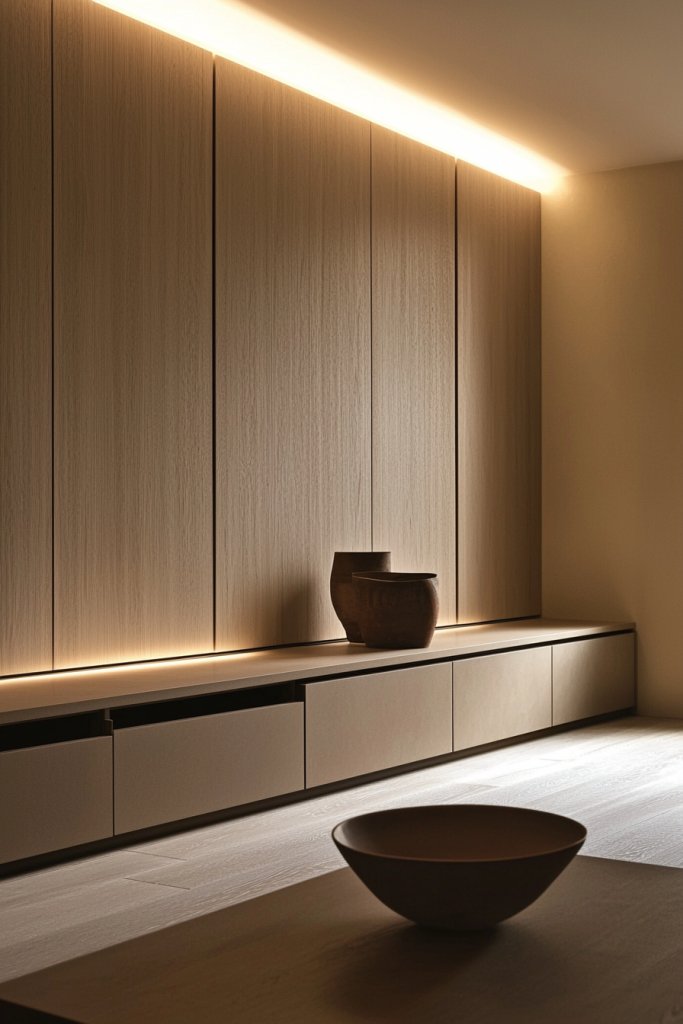
Sleek storage solutions with hidden compartments are the perfect way to keep your Japandi space looking pristine and clutter-free, embodying the minimalist ethos of calm and simplicity. By cleverly concealing everyday items, you create a serene environment where beauty and function coexist effortlessly.
Recommended Products to replicate this idea
| # | Preview | Product | |
|---|---|---|---|
| 1 |

|
Fsbecl Shoe Storage Cabinet for Entryway with 2 Flip Drawers, Narrow Wood Shoe Cabinet with Fluted... | Check Latest Price |
| # | Preview | Product | |
|---|---|---|---|
| 1 |

|
AIEGLE 95.1" W TV Stand with 4 Flip-Down Drawers, Modern Entertainment Center with Storage, Media... | Check Latest Price |
Imagine a low-profile sideboard made from light oak with flush, handleless drawers that seamlessly blend into the wall. Inside, hidden compartments neatly tuck away books, throws, or everyday essentials, maintaining clean, uninterrupted lines.
Soft, neutral tones like warm beige or muted grey dominate the palette, while smooth textures of matte wood and subtle metal accents add a sophisticated touch. The space feels quiet and uncluttered, with the gentle scent of natural wood and the faint whisper of a soft fabric throw inviting you to relax.
This design not only enhances visual serenity but also fosters a sense of order and calm throughout your room. To recreate this look, start with sleek, minimalist storage units—think low cabinets or sideboards in light wood or matte finishes.
You can find ready-made pieces with hidden compartments or opt for custom solutions that incorporate push-to-open drawers or sliding panels. Using simple tools like a screwdriver and a level, assemble and install your chosen storage, ensuring it aligns perfectly with your space’s clean lines.
If you prefer alternatives, consider furniture with built-in hidden drawers or modular units that can be easily reconfigured. Keep decor minimal around these storage pieces—perhaps a few handcrafted ceramics or a textured linen table runner—to maintain the tranquil, uncluttered aesthetic.
5. Textured Textiles in Soft, Muted Hues for Cozy Comfort
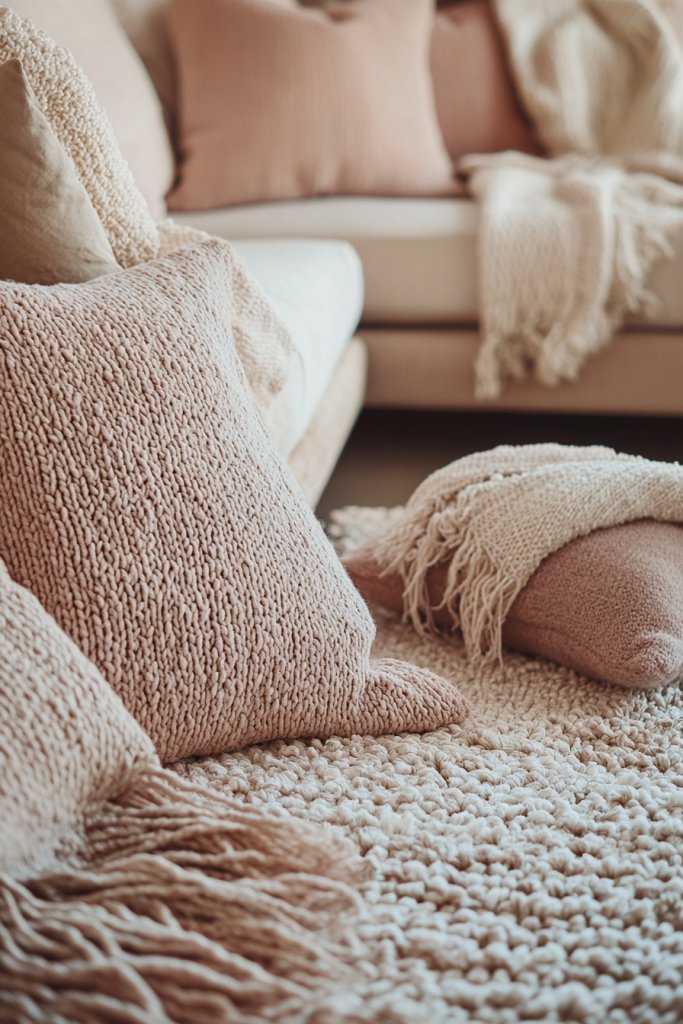
Adding textured textiles in soft, muted hues is a simple yet powerful way to infuse coziness and warmth into your Japandi-inspired space. These tactile accents help create a serene environment that feels inviting and perfectly balanced between minimalism and comfort.
Recommended Products to replicate this idea
| # | Preview | Product | |
|---|---|---|---|
| 1 |

|
Bedsure 100% Wool Blanket for Women Gift - GentleSoft and Cozy, Lightweight Warm Christmas Blanket... | Check Latest Price |
| # | Preview | Product | |
|---|---|---|---|
| 1 |

|
Valenrug Washable Rugs 8x10 - Stain Resistant 8x10 Area Rugs for Living Room, Non Slip Backing... | Check Latest Price |
Imagine draping a plush, oatmeal-colored wool throw over a low-profile sofa, or layering a linen cushion in a gentle blush tone with subtle, natural fibers. Soft, muted shades like dusty rose, warm beige, or cool greys dominate, while textures such as chunky knits, woven cotton, and smooth linen add visual interest and tactile warmth.
Underfoot, a textured jute or wool rug in neutral tones grounds the space, inviting barefoot strolls that stimulate the senses. The overall effect is a calm, cozy ambiance where every touch and sight encourages relaxation and mindfulness.
To recreate this look, start with a few key textiles: a chunky knit throw in a soft neutral, linen or cotton cushions in muted hues, and a textured area rug. You can find these materials at home goods stores or craft your own with natural fibers.
Mix and match different textures—think boucle, woven, and plush—to add depth without clutter. Drape your textiles thoughtfully over furniture or fold them neatly on beds and chairs for an effortlessly layered, inviting aesthetic. With a little effort, you’ll craft a space that feels warm and serene, perfect for unwinding after a busy day.
6. Sculptural Ceramics and Vases as Decorative Accents

Elevate your Japandi interiors with carefully chosen ceramic pieces that serve as both art and function, adding a touch of handcrafted elegance to your space. These sculptural ceramics and minimalist vases bring a subtle yet impactful visual interest, embodying the perfect blend of Japanese simplicity and Scandinavian restraint.
Recommended Products to replicate this idea
| # | Preview | Product | |
|---|---|---|---|
| 1 |
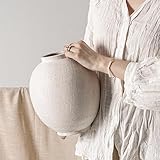
|
Large White Ceramic Vase - 9.8 Inch Rustic Farmhouse Vase for Home Decor, Minimalist Tall Vases for... | Check Latest Price |
| # | Preview | Product | |
|---|---|---|---|
| 1 |

|
Sculptural Clay Inspirations: 100s of Ceramic Artwork Ideas Organized by Subject Matter Theme (All... | Check Latest Price |
Imagine sleek, matte-finished vases in neutral tones like soft taupe, muted grey, or warm clay, with organic shapes that feel both modern and timeless. These vessels might feature asymmetrical curves or textured surfaces, standing on low coffee tables or shelves.
They can hold simple dried branches, bamboo stalks, or be left empty to highlight their sculptural form. The textures are often tactile—rough, ridged, or smooth—inviting touch and adding depth to your decor.
The overall effect creates a calm, curated aesthetic that emphasizes craftsmanship and understated beauty, enhancing the room’s serene atmosphere. To incorporate these accents, start by selecting handcrafted ceramics from local artisans or reputable online stores specializing in Japanese or Scandinavian-inspired pottery.
Opt for pieces with organic shapes and matte finishes that complement your color palette. Place them on open shelving, sideboards, or coffee tables for visual balance.
Keep the arrangement simple—avoid overcrowding—to preserve the minimalist essence. A few well-chosen ceramic pieces can serve as striking focal points that elevate your Japandi style effortlessly.
7. Layered Lighting with Warm, Soft Glow
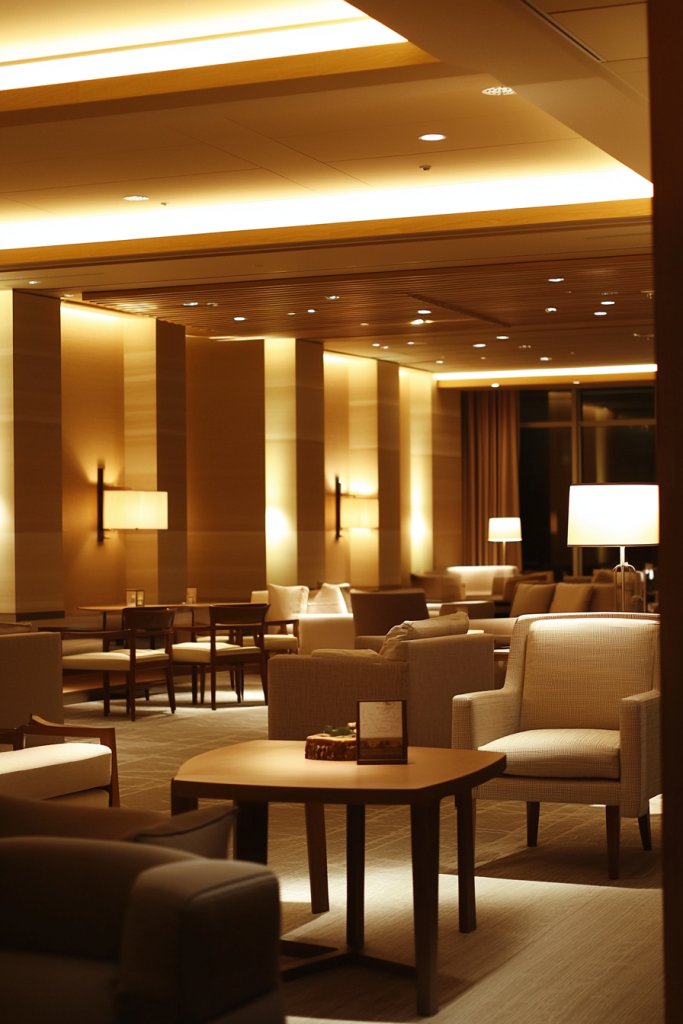
Creating a tranquil Japandi ambiance hinges on the right lighting—soft, warm, and layered to enhance the space’s serenity and comfort. Thoughtfully combining ambient, task, and accent lighting ensures your home feels cozy and inviting at any time of day or night.
Envision a room softly illuminated by a combination of paper lanterns with warm LED bulbs, minimalist pendant lights with matte black or wood accents, and flickering candles on side tables or shelves. The light sources cast gentle, diffuse glows that eliminate harsh shadows, fostering a peaceful environment.
Incorporate dimmable fixtures to adjust the mood effortlessly. The glow from these lights accentuates the natural textures of wood, textiles, and ceramics, creating a harmonious interplay of light and material.
The overall effect is soothing, almost meditative, encouraging relaxation and mindfulness. Achieving this layered lighting scheme is simple and budget-friendly.
Start with a central ceiling fixture or pendant, choosing designs with clean lines and warm-toned finishes. Add table lamps or wall sconces with soft white or amber bulbs, and include candles or tea lights in minimalist holders for a flickering, cozy effect.
Use timers or smart bulbs to control brightness levels and set a calming atmosphere easily. Keep the fixtures and bulbs consistent in color temperature, favoring warm tones around 2700K–3000K to maintain that inviting, serene glow.
8. Open Floor Plans with Seamless Flow Between Spaces
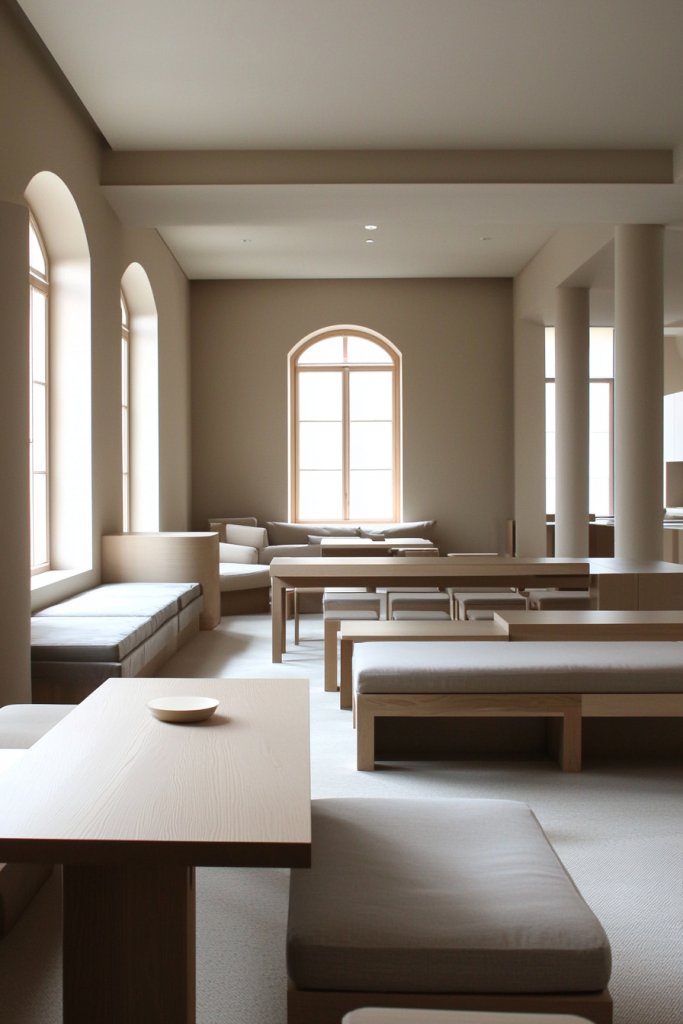
An open floor plan is essential for achieving the airy, harmonious feel characteristic of Japandi interiors, making the space appear larger, more inviting, and effortlessly peaceful. This design promotes a sense of flow, reducing visual clutter and encouraging a mindful, relaxed lifestyle.
Recommended Products to replicate this idea
| # | Preview | Product | |
|---|---|---|---|
| 1 |

|
Huatean Home 107" Modular Sectional Sofa, Sponge Sofa for Living Room, High Density Sponges Cloud... | Check Latest Price |
| # | Preview | Product | |
|---|---|---|---|
| 1 |

|
Shower Doors, 56–60'' W x 72'' H Sliding Glass Shower Door, Matte Black Aluminum Frame, 1/4''... | Check Latest Price |
Visualize a spacious living area with minimal partitions, where the seating zone, dining space, and perhaps a small workspace blend seamlessly. Light, neutral-colored rugs define different zones without walls, while low-profile furniture allows sightlines to remain open.
The layout encourages movement and conversation, fostering a sense of community and tranquility. Large windows with sheer curtains invite abundant natural light, which further enhances the fluidity and calm atmosphere.
The overall aesthetic emphasizes simplicity and spaciousness, with clutter kept to a minimum, allowing the natural textures of wood, textiles, and ceramics to shine. To implement this, start by choosing multipurpose furniture—such as low-profile sofas, extendable dining tables, and open shelving—that can serve multiple functions without crowding the space.
Remove unnecessary dividers, and consider installing sliding shoji screens or glass partitions if some separation is desired. Keep pathways clear and avoid overloading surfaces with decor.
Use consistent color schemes and materials throughout to unify the space visually. This approach creates a peaceful, flexible environment that embodies the Japandi philosophy of serene, functional living.
9. Japanese-Inspired Shoji Screens for Privacy and Aesthetic Appeal
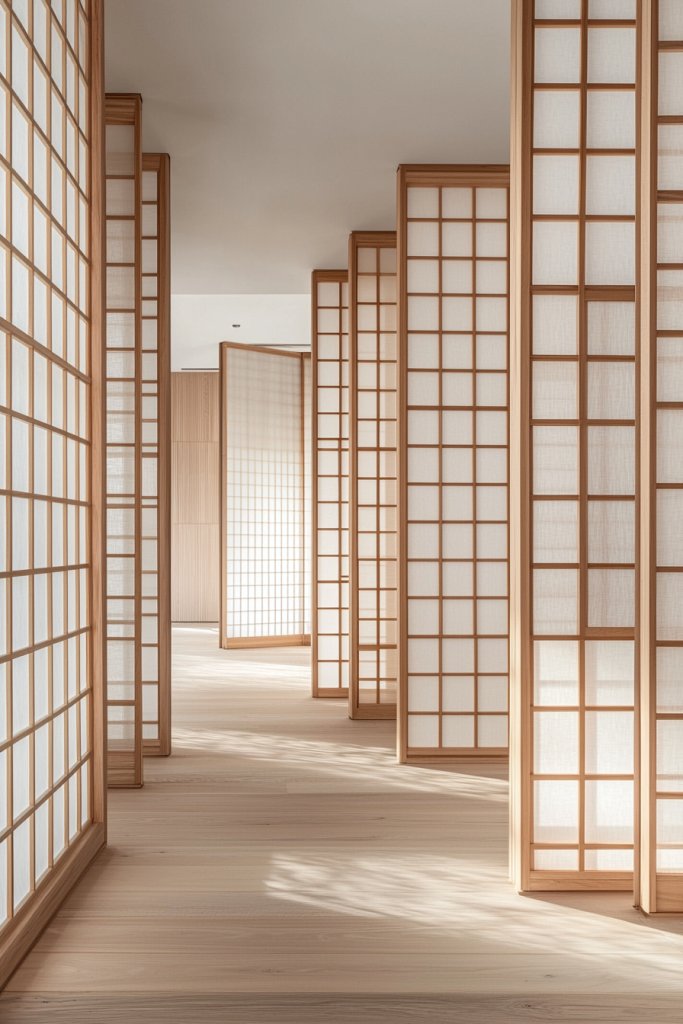
Shoji screens are a quintessential element of Japanese design, offering a subtle way to partition spaces while maintaining an overall sense of openness and harmony. Their delicate, grid-like appearance adds a touch of traditional elegance to modern Japandi interiors.
Picture lightweight wooden frames with translucent rice paper panels, sliding smoothly along minimalist tracks. These screens can be used to create private nooks within an open plan, conceal storage areas, or simply add visual interest to a room.
The soft diffused light passing through the paper panels creates a calming glow, enhancing the room’s serene atmosphere. The natural wood tones of the frames complement other materials like light oak, bamboo, or linen textiles, tying the design together.
Shoji screens add a layer of subtle sophistication and cultural authenticity, balancing modern minimalism with traditional craftsmanship. To incorporate shoji screens, choose adjustable or fixed models in light wood finishes that match your furniture and flooring.
For easy DIY installation, opt for pre-made sliding panels or kits available online. Place them strategically to divide spaces or soften the transition between areas, such as between a living and sleeping zone.
Keep the design simple—avoid overly ornate frames—to stay true to the Japandi aesthetic. Regular maintenance involves gentle cleaning of the paper panels and sliding tracks, but their lightweight nature makes them easy to handle and reposition as needed.
10. Monochromatic Decor Accents for Cohesive Serenity

Using monochromatic decor accents helps create a unified and tranquil environment, reinforcing the calming essence of Japandi interiors. Sticking to a single color palette with subtle variations cultivates visual harmony and a sense of order.
Recommended Products to replicate this idea
| # | Preview | Product | |
|---|---|---|---|
| 1 |

|
Utopia Bedding Throw Pillows (Set of 4, White), 18 x 18 Inches Pillows for Sofa, Bed and Couch... | Check Latest Price |
| # | Preview | Product | |
|---|---|---|---|
| 1 |

|
Zentavio Area Rugs for Living Room Grey Rugs for Bedroom 4x6 Carpet Fluffy Furry Soft Shag Aesthetic... | Check Latest Price |
Imagine selecting accessories like cushions, throws, or decorative objects all in shades of soft beige, warm taupe, or muted greys. For example, a plush cushion in a slightly different tone of the same hue layered on a low sofa, or a woven basket in a matching color, can subtly enhance the ambiance.
These accents can also include textured textiles like linen or wool, which add tactile richness without disrupting the overall calm. The key is consistency—using variations within the same neutral palette prevents visual chaos and encourages a peaceful, cohesive look.
This approach also makes mixing and matching decor easier, giving your space a curated, serene feeling. To implement, start by choosing a dominant neutral tone for your base—such as a soft cream or grey—and select decor items in matching shades or gentle variations.
Incorporate fabric swatches, rugs, and ceramics to reinforce the palette. Keep the number of contrasting colors to a minimum, focusing instead on textures and subtle differences in hue. This strategy simplifies decorating decisions and ensures your space remains visually calm, making it easy to refresh or update as your style evolves.
11. Zen-Inspired Water Features and Minimalist Fountains
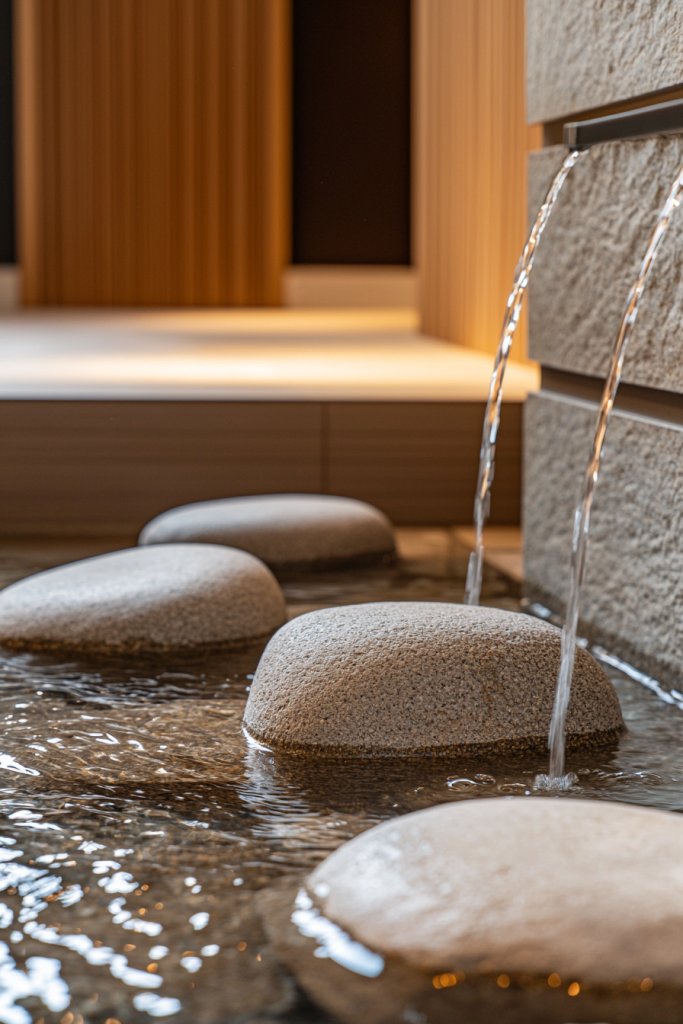
Creating a sense of calm in a Japandi interior can be beautifully enhanced with a Zen-inspired water feature or minimalist fountain. These elements introduce a gentle, soothing sound that helps drown out daily noise and fosters a tranquil atmosphere.
Recommended Products to replicate this idea
| # | Preview | Product | |
|---|---|---|---|
| 1 |

|
Lawfery Ceramic Cat Water Fountain, 2.1L/71oz Cat Fountain with 3 Carbon Filters and 2 Water Pumps,... | Check Latest Price |
| # | Preview | Product | |
|---|---|---|---|
| 1 |

|
Aquastrong Sump Pump 1 HP 4500 GPH Submersible Water Pump Thermoplastic Portable Utility Pump High... | Check Latest Price |
Think of a small, sleek stone basin with a thin, steady stream of water flowing over smooth surfaces, or a modern, sculptural fountain with clean lines that blends seamlessly into the space. The visual movement of water combined with its soft murmur evokes a sense of serenity and mindfulness, making it a perfect addition to a calming living area.
Visually, these water features tend to emphasize natural materials like stone, ceramic, or matte metals, often in neutral or muted tones such as grey, beige, or black. They are typically compact, designed to be subtle yet impactful, with a focus on simplicity and balance.
The water’s movement creates a sense of rhythm that complements the overall minimalist aesthetic, while the tactile surface of the stones or ceramics invites gentle interaction. When lit softly, especially at night, they cast subtle reflections and shadows, enhancing the peaceful ambiance.
The space around the fountain is usually uncluttered, with natural wood or woven elements nearby to reinforce the organic feel. To incorporate this idea, start with a small, portable fountain or water basin made of ceramic, stone, or matte metal.
Place it on a simple wooden or stone pedestal or directly on the floor. Use a quiet, energy-efficient pump to ensure a gentle flow—these are widely available online or at home improvement stores.
Keep the surrounding area free of clutter, and add a few natural accents like pebbles or driftwood to enhance the Zen vibe. For a more authentic touch, choose a water feature with a subtle, almost meditative sound that encourages mindfulness and relaxation.
12. Functional yet Elegant Side Tables and Coffee Tables

A Japandi interior benefits from tables that are both practical and visually understated, serving as versatile anchors in the space. Think of a simple, low-profile coffee table crafted from light-colored wood with sleek, clean lines, or a minimalist side table with a subtle tapered leg design.
Recommended Products to replicate this idea
| # | Preview | Product | |
|---|---|---|---|
| 1 |

|
LITTLE TREE Farmhouse Coffee Table, 47 Inches Wooden Rectangular Accent Center Tables with Thick... | Check Latest Price |
| # | Preview | Product | |
|---|---|---|---|
| 1 |

|
Sopicoz Table Legs 16 inch Wood Furniture Legs for Coffee Table End Table Mid-Century Modern DIY... | Check Latest Price |
These pieces should blend seamlessly into the environment, providing surface space without dominating the room. Their understated elegance creates a balanced, harmonious look that keeps the space feeling open and clutter-free.
Visually, these tables tend to feature natural materials like light oak, ash, or walnut, often finished in matte or natural oil for a soft, organic appearance. The design is typically geometric and unadorned, focusing on proportion and craftsmanship.
The surface might be smooth or slightly textured, inviting tactile interaction, while the legs are slim and unobtrusive, contributing to a sense of lightness. They can be paired with soft textiles—like a cozy wool throw draped over the edge—or topped with handcrafted ceramics or sculptures that add visual interest without overwhelming the minimalist aesthetic.
The overall effect is a calm, balanced space that feels effortless and refined. To recreate this look, choose a simple table made from sustainable or reclaimed wood for eco-conscious appeal.
For DIY options, consider repurposing a sturdy wooden crate or pallet into a low table, sanding it smooth and sealing the surface. For a ready-made piece, look for those with minimalist profiles, such as a round or rectangular top with tapered legs.
Position your tables close to seating areas or in corner niches, and keep the surfaces clear of excess decor—just a thoughtfully chosen ceramic vase or a small sculpture will suffice. This approach ensures functionality while maintaining the tranquil, uncluttered vibe characteristic of Japandi style.
13. Clutter-Free Surfaces with Thoughtful Decor Placement
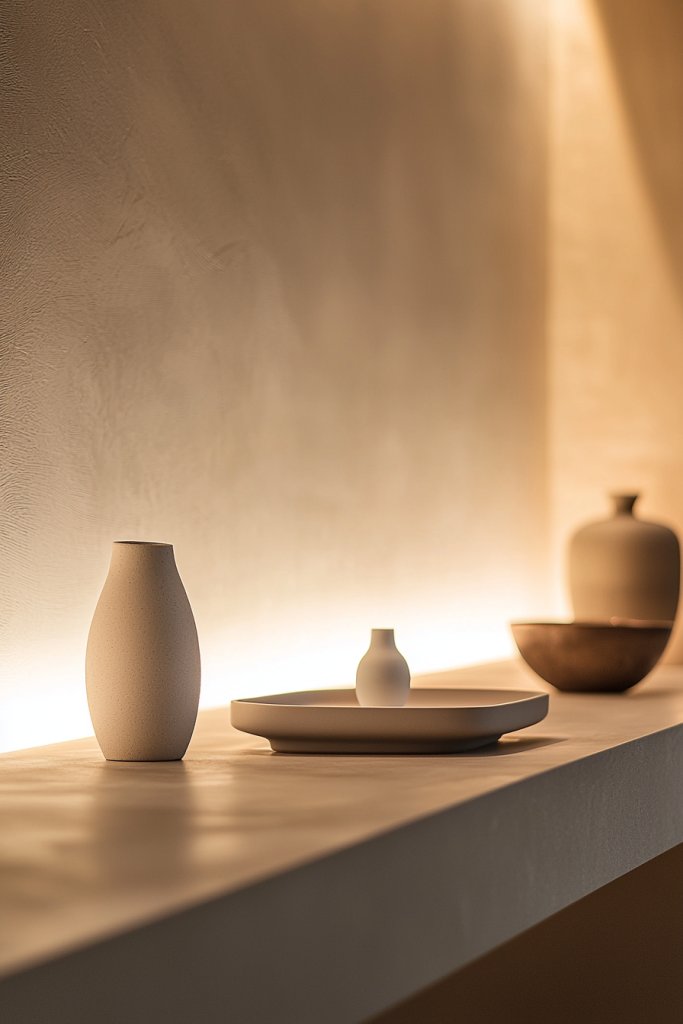
Achieving serenity in a Japandi space hinges on keeping surfaces clean and thoughtfully curated. Cluttered surfaces disrupt visual harmony and can create a sense of chaos, so strategic decor placement is essential.
Recommended Products to replicate this idea
| # | Preview | Product | |
|---|---|---|---|
| 1 |

|
Large White Ceramic Vase - 9.8 Inch Rustic Farmhouse Vase for Home Decor, Minimalist Tall Vases for... | Check Latest Price |
| # | Preview | Product | |
|---|---|---|---|
| 1 |

|
Small Wood Tray Pedestal Stand Farmhouse Bathroom Decor Decorative Wooden Riser Kitchen Soap Dish... | Check Latest Price |
Focus on a few carefully selected objects—such as a textured ceramic bowl, a simple wooden tray, or a minimalist sculpture—and arrange them with intention. The goal is to create a balanced composition that feels effortless and calming, encouraging mindful appreciation of each piece.
Visually, this means choosing decor in neutral or muted tones—think soft greys, warm beiges, and subtle earth hues—and varying textures to add depth. Place larger items like a ceramic vase or a stone sculpture as focal points, then complement them with smaller accents like candles, woven coasters, or small plants in understated holders.
Keep flat surfaces, such as coffee tables, sideboards, or countertops, mostly clear, with only 2-3 items displayed at a time. This creates breathing space and emphasizes quality over quantity, reinforcing a sense of order and tranquility.
To implement this, start by decluttering your surfaces and selecting a few meaningful items that resonate with the Japandi aesthetic. Use a small tray or wooden box to group related objects, keeping them organized and visually cohesive.
Rotate decor seasonally or as your mood changes to keep the space fresh without adding clutter. Regularly assess your surfaces, removing anything unnecessary, and focus on spacing objects evenly to avoid overcrowding. This disciplined approach to decor ensures your space remains peaceful, functional, and visually appealing.
14. Artful Use of Mirrors to Enhance Light and Space
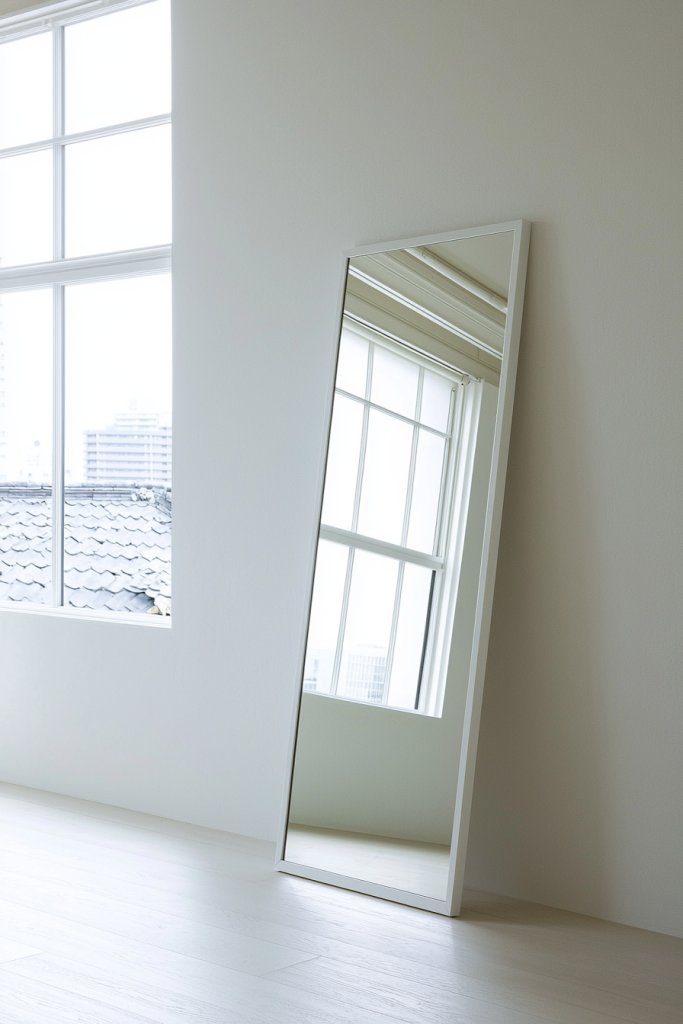
Mirrors are a simple yet powerful tool in a Japandi interior, used to reflect natural light and visually expand the space. An understated, frameless mirror or one with a sleek, wooden frame can be hung strategically across from windows or near light sources to amplify brightness and create a sense of openness.
Recommended Products to replicate this idea
| # | Preview | Product | |
|---|---|---|---|
| 1 |

|
Ruomeng Rectangle Wall Mirror Frameless Bathroom Mirror 16” x 24" Beveled Edge Mirror for Vanity... | Check Latest Price |
| # | Preview | Product | |
|---|---|---|---|
| 1 |

|
ZHUNFA Arched Full Length Mirror with Solid Wood Frame, 71x32 Farmhouse Wall Mounted Floor Mirror... | Check Latest Price |
Their reflective surface not only enhances the room’s light but also adds a subtle decorative element that complements the minimalist aesthetic. In visual terms, mirrors in Japandi interiors tend to be rectangular or round with slim, unobtrusive frames made from natural wood or matte metals.
They are placed thoughtfully—above a low sideboard, beside a cozy reading nook, or as part of a visual vignette with carefully curated objects. The mirror’s simplicity allows it to blend seamlessly into the decor, while its reflective quality bounces light around the room, making even small spaces feel larger and more inviting.
When illuminated by soft, warm lighting, they contribute to the tranquil, cozy atmosphere that defines Japandi style. To incorporate a mirror, select a piece with a minimalist frame in natural wood, black metal, or frameless design.
Hang it at eye level in a location where it can catch natural or ambient light, such as opposite a window or near a light source. Keep the surrounding decor simple—perhaps a small shelf or console table underneath for a few curated objects—so the mirror remains the focal point. Regularly clean the surface to maintain clarity and brightness, and experiment with different placements to find the most harmonious setup that enhances your space’s serenity.
15. Subtle Patterns and Geometric Shapes in Textiles and Decor
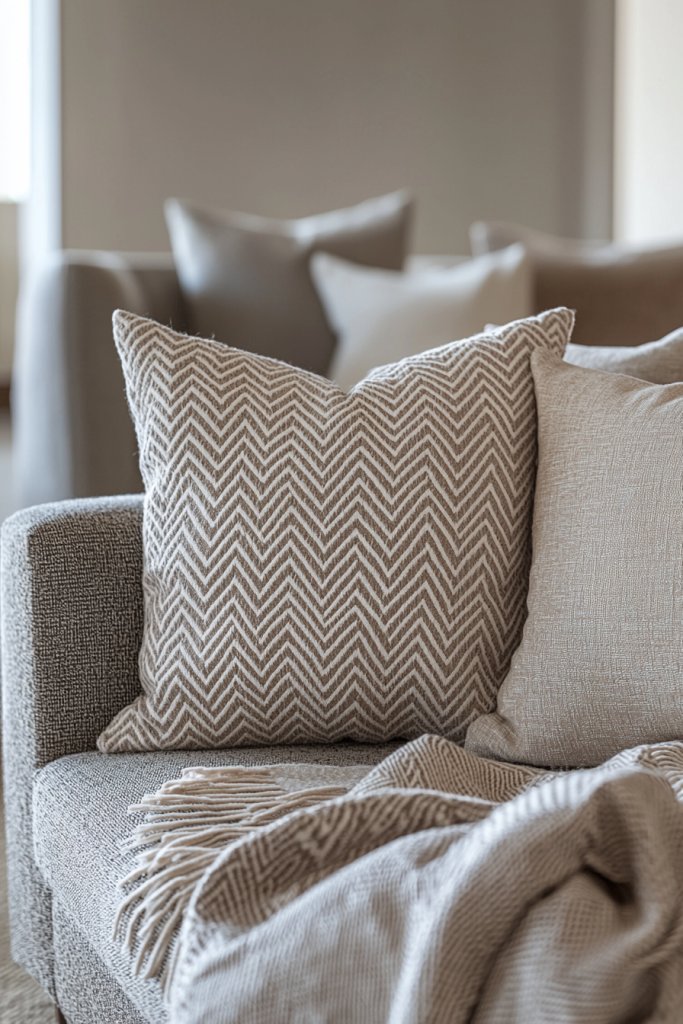
In a Japandi interior, subtle patterns and geometric shapes add visual interest without disrupting the space’s serene simplicity. Think of soft, understated textiles with delicate chevrons, gentle stripes, or minimalist grid patterns, crafted in muted tones like taupe, blush, or charcoal.
Recommended Products to replicate this idea
| # | Preview | Product | |
|---|---|---|---|
| 1 |

|
Foindtower Pack of 2, Decorative Linen Soild Throw Pillow Covers Soft Accent Cushion Case Boho... | Check Latest Price |
| # | Preview | Product | |
|---|---|---|---|
| 1 |

|
S & L Homes Jute Cotton Hand Woven Natural Farmhouse Area Rug for Living Room - Rustic Vintage... | Check Latest Price |
These patterns bring a touch of personality while maintaining the overall calm, harmonious vibe—adding just enough detail to keep the space engaging yet peaceful. Visually, these elements often appear in textiles such as linen or cotton cushions, throws, and rugs, featuring simple geometric motifs that are neither overwhelming nor overly busy.
The textures are soft and tactile—like a chunky knit throw in a muted hue or a woven rug with subtle linear patterns—adding depth and warmth. Accessories like ceramic bowls or vases can also incorporate geometric shapes, echoing the textiles’ motifs and reinforcing a cohesive look.
The key is to keep the patterns delicate and restrained, allowing the natural materials and neutral palette to shine. To incorporate these subtle patterns, choose textiles in natural fibers like linen or wool, with patterns that are simple and understated.
For example, a soft cotton cushion with a faint chevron pattern or a wool rug with a minimalist geometric design can elevate the space without cluttering it. Mix and match textures—smooth ceramics with textured textiles—to create visual interest while preserving the peaceful aesthetic. Keep decorative objects minimal and carefully curated, focusing on quality and simplicity for a balanced, serene environment.
16. Scandinavian-Inspired Mesh Baskets and Storage Containers
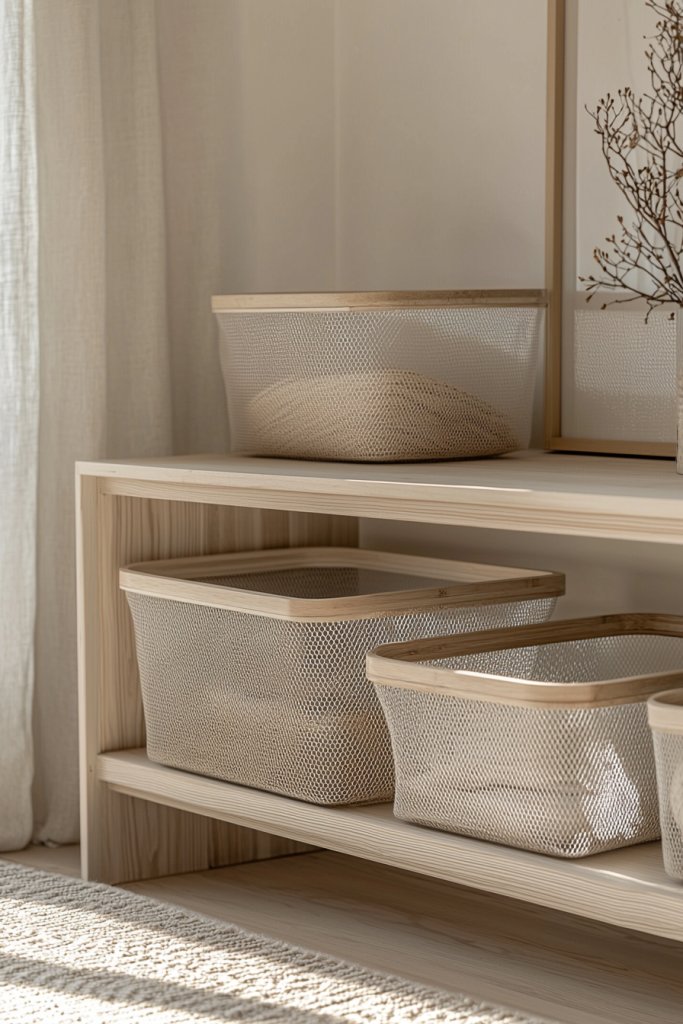
In the world of Japandi design, functional storage solutions are essential for maintaining a clutter-free, serene environment. Scandinavian-inspired mesh baskets and containers not only serve a practical purpose but also add a touch of texture and visual interest, seamlessly blending minimalist aesthetics with subtle craftsmanship.
Picture a set of lightweight, airy mesh baskets made from natural or painted metal, resting neatly on open shelving or tucked into corner niches. These baskets come in neutral shades like soft greys, warm beiges, or black, complementing the overall calm palette.
Their breathable structure allows for easy identification of contents, whether it’s rolled-up towels, cozy throws, or small accessories. The tactile quality of the mesh contrasts beautifully with smooth wood or ceramic elements, adding depth without overpowering simplicity.
The overall look is effortless and understated, evoking a sense of order and tranquility in the space. To recreate this look, start with metal mesh baskets or woven fabric containers—these are widely available at home goods stores or online.
Choose sizes that fit your storage needs and space constraints. For a cohesive palette, opt for neutral colors like matte black, soft grey, or natural wood tones.
Position these baskets within open shelving, under side tables, or inside cabinets for a clean, organized appearance. For added durability or a personalized touch, you can spray paint or line the baskets with fabric. The key is to keep the arrangement simple, functional, and harmonious with the rest of your Japandi decor.
17. Harmonious Balance of Modern and Traditional Elements
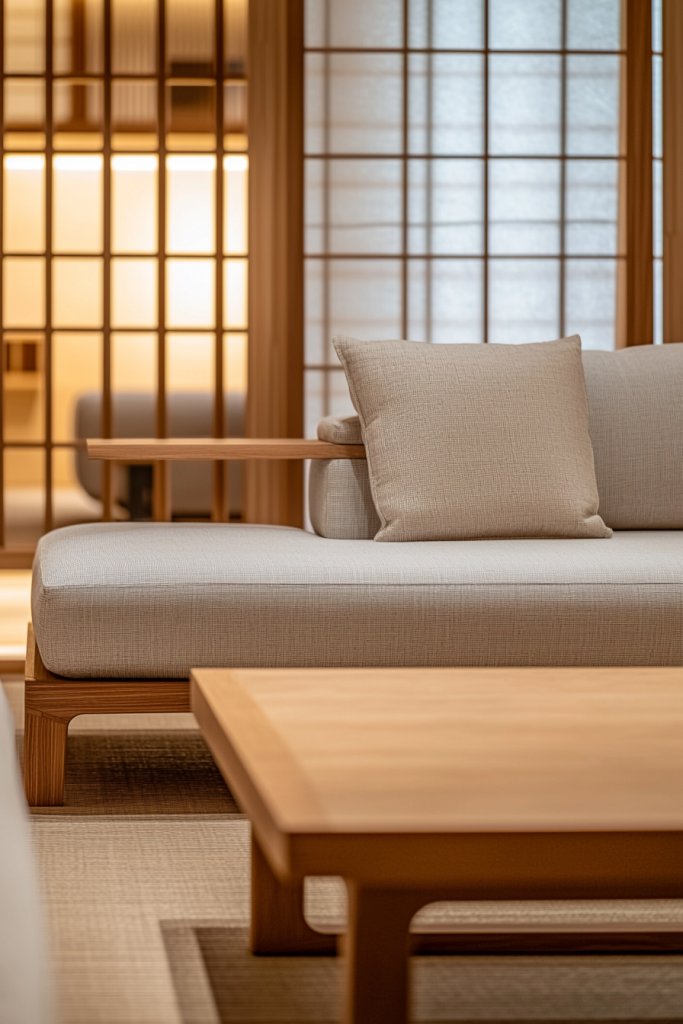
Achieving a timeless serenity in Japandi interiors often comes down to expertly blending sleek, modern pieces with subtle traditional Japanese accents. This balance creates a space that feels both current and deeply rooted in cultural heritage, embodying the essence of calm sophistication.
Recommended Products to replicate this idea
| # | Preview | Product | |
|---|---|---|---|
| 1 |

|
114" Oversized Sectional Sofa for Living Room, Modern Luxury Plush Chenille 4-Seater Extra Deep &... | Check Latest Price |
| # | Preview | Product | |
|---|---|---|---|
| 1 |

|
VASAGLE MAEZO Collection - Side Table, 2-Tier Small Round End Table, Nightstand with Tapered Legs,... | Check Latest Price |
Imagine a living room where a streamlined, minimalist sofa is paired with a handcrafted wooden side table featuring traditional joinery details. The room’s color palette is muted—think warm taupes, soft greys, and natural wood finishes—allowing each element to breathe.
A low-profile coffee table with clean lines sits beside a textured woven throw blanket, while a simple ceramic sculpture or a subtle woven basket introduces a dash of handcrafted charm. The space feels effortlessly cohesive, with the modern elements grounding the design and the traditional touches adding warmth and personality.
The overall atmosphere is one of balanced tranquility, where each piece enhances the whole without competing. To bring this harmony into your space, start by selecting sleek, contemporary furniture like a low-profile sofa or modern side tables in neutral tones.
Then, incorporate traditional Japanese-inspired details—such as handcrafted wooden bowls, woven textiles, or ceramic vases—that add texture and cultural depth. Mix these with modern finishes like matte metals, glass, or smooth lacquered surfaces.
The key is to aim for a seamless integration: choose pieces that visually complement each other in proportion and tone, creating an environment that feels both fresh and timeless. This thoughtful blend results in a peaceful, sophisticated room that celebrates both the new and the nostalgic.
Conclusion
These 17 Japandi interior moodboard ideas offer a diverse yet harmonious blueprint for creating serene, stylish living spaces that balance simplicity with warmth. From calming neutral palettes and natural textures to clever storage solutions and traditional accents, each element contributes to a peaceful, uncluttered environment.
We encourage you to experiment with these concepts and infuse your home with the tranquil elegance of Japandi design. Embrace the journey toward a more serene, beautifully balanced space—your perfect sanctuary awaits.

Leave a Reply